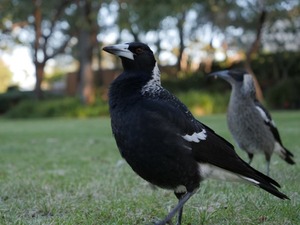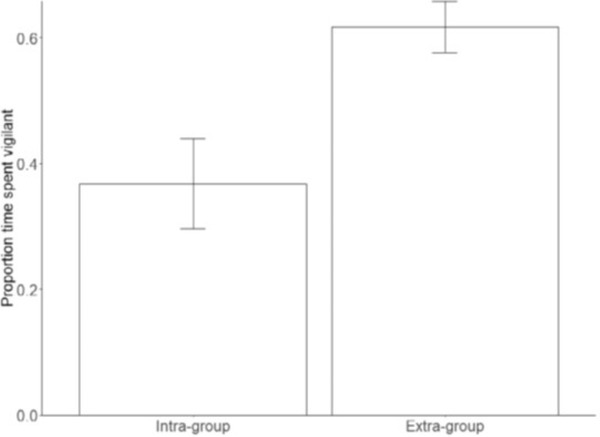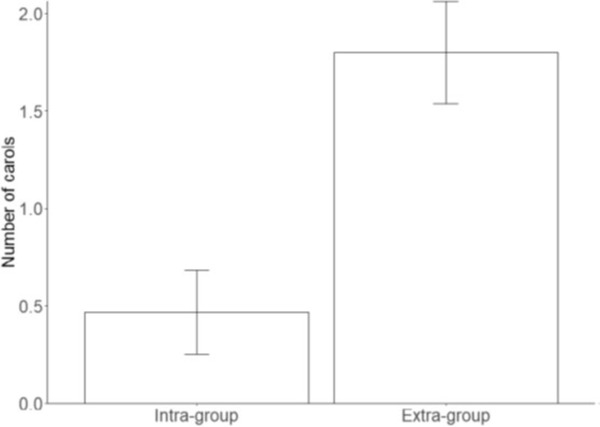 LINKED PAPER
LINKED PAPER
Australian Magpies discriminate between the territorial calls of intra- and extra-group conspecifics. Blackburn, G., Ridley, A.R. & Dutour, M. 2022 Ibis. doi: 10.1111/ibi.13151 VIEW
In nearly all taxa, from insects to birds to non-human mammals and even people, the ability to distinguish between different individuals or between different groups of individuals based on distinct cues is of vital importance (Tibbets & Dale 2007; Yorzinski 2017). Many species rely on vocal signals to differentiate between individuals, a skill known as vocal discrimination. There are a number of advantages that come with vocal discrimination abilities – individuals are better able to distinguish between the vocalisations of good versus poor quality mates (Mennill et al. 2002); they’re able to recognise and care for their own offspring (Aubin & Jouventin 1998); they can understand and maintain complex dominance hierarchies (Tibbets & Dale 2007); and they’re able to distinguish reliable from unreliable individuals (Silvestri et al. 2019). While vocal discrimination abilities have been seen across numerous species, this skill is considered particularly important for group-living territorial species, as these species must be not only able to distinguish between groupmates and non-groupmates, but also between different individuals within their own group.

Figure 1 Western Australian Magpies chorusing © James Blackburn.
The Western Australian subspecies of Australian Magpie (Gymnorhina tibicen dorsalis) are a highly social group-living bird species. These birds live in cooperatively stable groups of 2 to 12 adult individuals that maintain a year-round territory. This species is highly territorial, often engaging in high-risk vocal and physical disputes with other groups for resources such as food, territory, and mating opportunities. Therefore, vocal discrimination abilities may be of particular importance in this species due to a high number of daily interactions with conspecifics, both within and outside of their social group.
Vocal discrimination in magpies
To determine if magpies possess the ability to discriminate between groupmates and non-groupmates, we conducted playback experiments on 15 adult females to see if they responded differently to the carolling calls of magpies from their own social group (intra-group carols) and carolling calls of magpies outside of their social group (extra-group carols). The response of magpies to playback tracks were video recorded, and from these recordings, experimenters determined (1) the time that individuals spent vigilant in the 30 seconds following playback, and (2) the number of carolling calls focal magpies produced in the 30 seconds following playback.
We found that focal magpies spent significantly more time vigilant and produced significantly more carols in response to playback of extra-group carols, compared to playback of intra-group carols. The significant differences in magpie response to the carolling calls of intra-group and extra-group individuals suggests that Western Australian Magpies are able to vocally discriminate between groupmates and non-groupmates.

Figure 2 Average proportion of time spent vigilant in the 30 seconds following intra-group and extra-group carols.

Figure 3 Average number of carols produced by the focal bird in the 30 seconds following intra-group and extra-group carols.
This increased response seen following playbacks of extra-group carols is likely due to the highly territorial nature of this species. Western Australian magpies defend their territories year-round, often engaging in high-risk territorial disputes with surrounding groups (Hidayat 2018; Dutour et al. 2020). As carols represent the main territorial song in this species, the playback of an extra-group carol in the territory of a focal bird may be seen as a threat to the focal bird, explaining their heightened response to this extra-group carol.
In this experiment, we found evidence for vocal discrimination in Western Australian Magpies. This skill is likely to be highly beneficial for this group-living, territorial subspecies. Our results add to the growing body of research documenting vocal discrimination abilities across species and highlight the importance of such abilities to social and territorial species.
References
Aubin, T. & Jouventin, P. 1998. Cocktail-party effect in king penguin colonies. Proceedings of the Royal Society B 265: 1665-1673. VIEW
Dutour, M. & Ridley, A.R. 2020. Females sing more often and at higher frequencies than males in Australian Magpies. Behavioural Processes 172: 104045. VIEW
Hidayat, O. 2018. Understanding Relationship between Group Size and Territory Size by a Social-Living Species, the Western Australian Magpie (Cracticus Tibicen Dorsalis). Perth, WA: The University of Western Australia.
Mennill, D.J., Ratcliffe, L.M. & Boag, P.T. 2002. Female eavesdropping on male song contests in songbirds. Science 296: 873. VIEW
Silvestri, A., Morgan, K. & Ridley, A.R. 2019. The association between evidence of a predator threat and responsiveness to alarm calls in Western Australian Magpies (Cracticus tibicen dorsalis). PeerJ 7: 37572. VIEW
Tibbetts, E.A. & Dale, J. 2007. Individual recognition: it is good to be different. Trends in Ecology & Evolution 22: 529-537. VIEW
Yorzinski, J.L. 2017. The cognitive basis of individual recognition. Current Opinion in Behavioral Sciences 16: 53-57. VIEW
Image credit
Top right: Western Australian Magpie (Gymnorhina tibicen dorsalis) © James Blackburn.
If you want to write about your research in #theBOUblog, then please see here.



